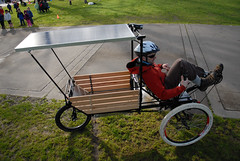Introducing the Hauler — a solar, sweat and electric powered vehicle its designers hope will bridge the gap between bicycle and car and bring a new level of utility and affordable mobility to millions in the process.
The Hauler is a product of Hood River-based Senkai Motor Works (Senkai is “revolution” in Japanese). The three men behind it are Aaron Blake, 29, Adam Kravetz, 30, and Tris Tarantino, 28. I caught up with Blake and Kravetz between meetings with potential investors during a recent visit to Portland.
“We’re trying to obviate the internal combustion engine market before car makers can push it even further downmarket.”
— Aaron Blake, Senkai Motor Works
From nearly the moment Blake started talking, I knew he wasn’t your average bike tinkerer with a big idea. Blake isn’t looking to get the Hauler into a few bike shops or make them one at a time from his shop in Hood River, and he’s more likely to base business decisions on what he reads in The Economist rather than Bicycle Retailer and Industry News.
This guy wants to go global:
“We’re looking at demographic trends in China and our goal is to make this available for the millions that make less than $5,000 a year…. they will never buy a Tata [the low-priced car from India].”
Blake and Kravetz refer to the Hauler as a “human utility vehicle.” “Legally it’s an electric bike,” says Kravetz, “and that’s how we describe it to people, but it’s significantly different from a bicycle. It’s between the scale of a bicycle and a car.”
For starters, the Hauler comes with a 500 pound payload. It has three wheels — two up front (which drive the vehicle) and one in the back (which steers). The ride is very smooth thanks to leaf springs on the front axle. The components are a mix of off-the-shelf and custom.
There’s a dual vision for the Hauler. Kravetz and Blake think it can be both a path to economic independence for poor people in developing countries and a feasible alternative to cars in places like Portland.
In wealthy countries, Blake sees a huge opportunity for the Hauler to be part of the sustainability solution. Even if there was a massive shift to electric cars, he says, it wouldn’t make enough of an impact on the planet’s energy footprint:
“We need to cut emission by factors of ten instead of simply shifting our current level of use to a different form. Our interest is in providing a vehicle that gets approx. 900 mpg from an outlet to offset the use of vehicles that get 20 mpg from gas or 60-100 mpg from an outlet.”
One of the most interesting features of the Hauler is the solar panel that doubles as a roof over the cargo bin. This is a feature that Blake says was created with developing countries in mind:
“One of the biggest obstacles to improving lives and creating sustainable, small-scale economies in the developing world is energy poverty… the solar panel was designed explicitly as a solution to that.”
Blake says the solar panel is the same size used by NGO’s to power businesses, schools, and hospitals in developing countries. It was designed to easily detach from the vehicle to be put to use in building “ad-hoc, off-grid power solutions.”
For those of us who live where “energy poverty” is not as much of an issue, the solar panel extends the range of the motor. Over the course of a day it can give the electric battery one full charge. Kravetz says their test riders are currently getting between 30-60 miles of use on one charge.
Operating the Hauler is very easy — once you get the hang of it.
The steering happens via grips near your hips and the pedals are out in front of you. Give the throttle a bit of a push and you feel an instant surge from the motor. During my test ride I got going a little too fast on a slight downhill and careened into a concrete wall. The chainrings hit the wall first, the vehicle tipped, and I flew to the ground. I wasn’t hurt, but it turned out to be a great test of the Hauler’s durability.
Despite running directly into a wall at about 18-20 mph, the only damage was bent chainrings and a taco’d wheel. Because the wheels are strong and have loads of clearance, the Hauler could still roll easily. And, even though the drivetrain no longer worked, I just shook myself off, hit the throttle and kept on rolling.
The current price is around $2,600 (without the solar panel), but the idea is to bring the price way down. “Our goal,” says Blake, “is $500 U.S.D. in the Chinese market within the next couple of years.” To Blake, it’s a race to the bottom. According to his calculations a car costs about $9,000 a year to operate and about $54 dollars per 100 miles driven. The Hauler on the other hand, costs about 50 cents per 100 miles driven.
“We’re trying to obviate the internal combustion engine market before car makers can push it even further downmarket.”
No one can accuse these guys of not thinking big. Now all they need is some venture capital.
– See the full photo gallery SenkaiMotorWorks.com.
UPDATED: Check out this brief video I put together of the Hauler in motion:








